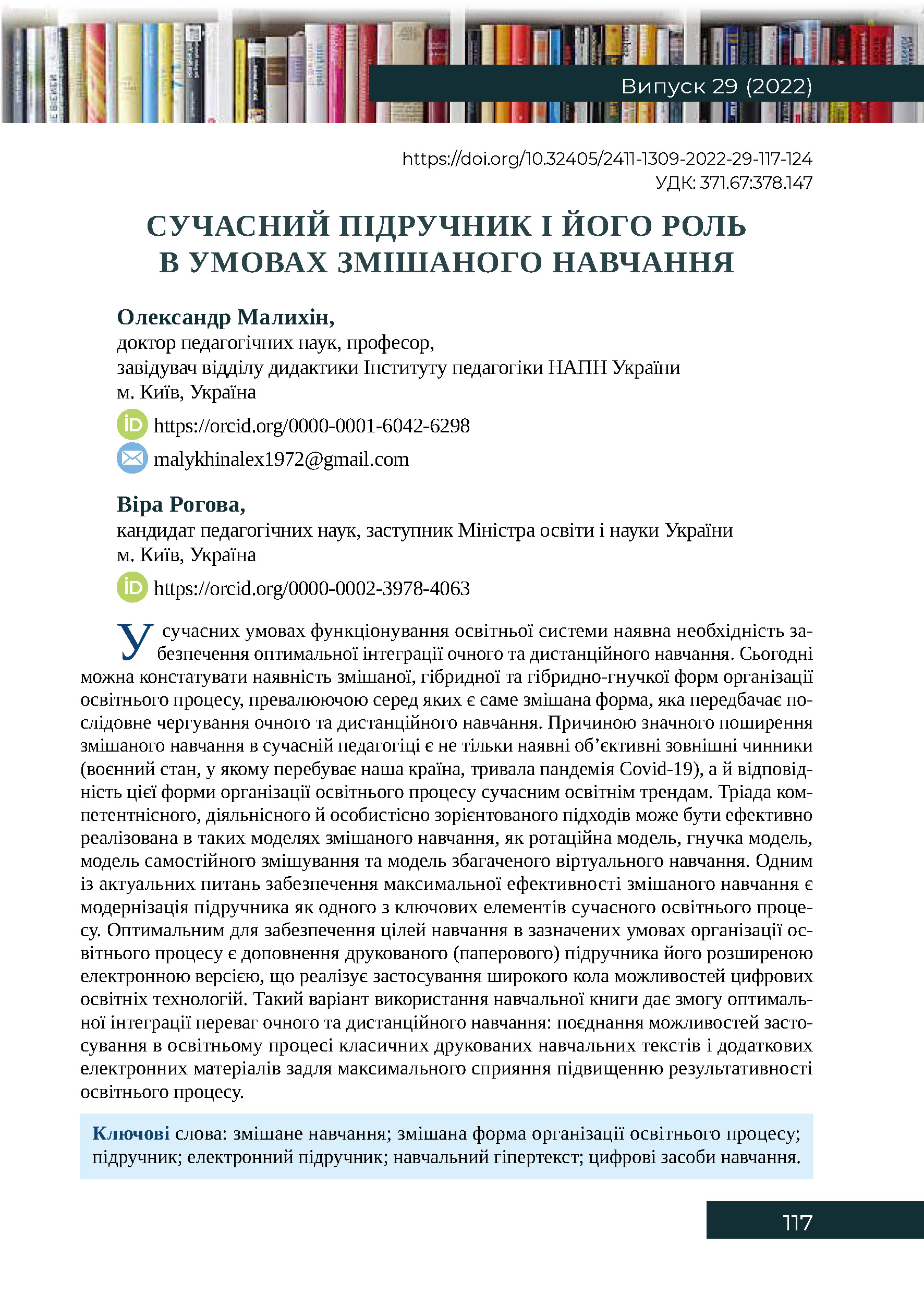
Published 2023-02-06
Keywords
- blended learning,
- blended form of educational process organization,
- textbook,
- electronic textbook,
- educational hypertext
- digital learning tools ...More
How to Cite

This work is licensed under a Creative Commons Attribution-NonCommercial-ShareAlike 4.0 International License.
Abstract
In the modern conditions of functioning of the educational system, there is a need to ensure optimal integration of full-time and distance learning. Today, we can state the presence of blended, hybrid and hybrid-flexible forms of organizing the educational process, the predominant one among which is the blended form. It involves consecutive alternating full-time and distance learning: with this approach, students work in a virtual environment for a certain period, and then use a traditional (educational) environment. The reason for the widespread spread of blended learning in modern pedagogy is not only the existing objective external factors (unprovoked aggression of the russian federation, the Covid-19 pandemic), but also the compliance of this form of organization of the educational process with modern educational trends. The triad of competency-based, activity-based, and personally-oriented approaches can be effectively implemented in such blended learning models as the rotary model, the flexible model, the self-blending model, and the enriched virtual learning model. One of the most pressing issues of ensuring the maximum effectiveness of blended learning is the preparation of a modern textbook as one of its key elements. Optimal for ensuring the goals of training in these conditions is to supplement the printed (paper) textbook with its extended digital version, which implements the use of a wide range of opportunities for digital educational technologies. This version of the educational book implementation makes it possible to optimally integrate the advantages of full-time and distance learning: combining the possibilities of using classic printed educational texts and additional electronic materials in the educational process in order to maximize the effectiveness of the educational process.
Downloads
References
- Житєньова, Н. В. (2020). Теоретичні і методичні засади професійної підготовки майбутніх учителів природничо-математичних дисциплін до використання технологій візуалізації в освітньому процесі. Дисертація доктора педагогічних наук, Харківський національний педагогічний Університет імені Г.С. Сковороди. http://hnpu.edu.ua/sites/default/files/files/Rada/D_64_053_04/zhytenyova/Dis_Zhytienova_1603206063.pdf
- Кодлюк, Я. П. (2014). Концептуальні основи побудови підручника для початкової школи. Проблеми сучасного підручника, (14), 284–292.
- Кремень, В. (Ред.). (2021). Енциклопедія освіти (2-ге вид.). Київ: Юрінком Інтер.
- Малихін, О., Арістова, Н., & Рогова, В. (2022). Мінімізація освітніх втрат учнів закладів загальної середньої освіти в умовах воєнного стану: Змішане навчання. Український педагогічний журнал, (3), 68–75. https://doi.org/10.32405/2411-1317-2022-3-68-76
- Малихін, О., Арістова, Н., Шпарик, О. (2021). Використання позитивного досвіду організації освітнього процесу в країнах ЄС в умовах непрогнозованих глобальних впливів у системі національної освіти України. Київ: КОНВІ ПРІНТ. https://undip.org.ua/wp-content/uploads/2021/12/21-30.pdf
- Малихін, О. В., & Ліпчевська, І. Л. (2022). Візуалізація навчальної інформації як складова цифрових підручників для початкової школи. У Проблеми сучасного підручника: Навчально-методичне забезпечення освітнього процесу в умовах воєнного часу (с. 208–211). Педагогічна думка. https://lib.iitta.gov.ua/732111/1/Text1.pdf
- Пометун, О. І., Гупан, Н. М. (2014). Проектування шкільного підручника: Вимоги і проблеми. Проблеми сучасного підручника, (14), 564–573.
- Baron, N. S. (2021). How we read now: Strategic choices for print, screen, and audio. Oxford University Press.
- De Koning, B. B., & van der Schoot, M. (2013). Becoming part of the story! Refueling the interest in visualization strategies for reading comprehension. Educational Psychology Review, 25(2), 261–287. https://doi.org/10.1007/s10648-013-9222-6
- International Bureau of Education. (n. d.). Blended Learning. http://www.ibe.unesco.org/en/glossary-curriculum-terminology/b/blended-learning
- Malykhin, O., Aristova, N., & Alieksieieva, S. (2022). Boosting lifelong learning for general secondary schoolteachers: Digital competence development amid blended learning. SOCIETY. INTEGRATION. EDUCATION. Proceedings of the International Scientific Conference, 1, 819–827. https://doi.org/10.17770/sie2022vol1.6859
- Topuzov, O., Malykhin, O., & Aristova, N. (2021). System of psychological and didactic tasks players in the educational process face in the paradigm «Teachers – Schoolchildren – Parents» amid the Covid-19 pandemic. Education: Modern Discourses, (4), 23–31. https://doi.org/10.37472/2617-3107-2021-4-03
- Topuzov, O., Malykhin, O., & Aristova, N. (2022). General secondary teachers’ views on educational process amid the Covid-19 pandemic: Two-year experience of blended learning. SOCIETY. INTEGRATION. EDUCATION. Proceedings of the International Scientific Conference, 1, 549–559. https://doi.org/10.17770/sie2022vol1.6841
